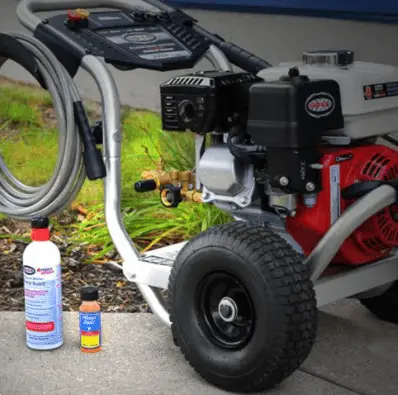Pressure washers are very vital machines when it comes to cleaning our home exteriors such as patios, driveways, fences, walls, garages and cars. If you have no plans to use your pressure washer for the next couple of weeks, it is essential to protect its engine, pump system and internal seals.

Winterizing your gas or electric pressure washer for storage during off-season makes it to remain in good shape and ready when the season comes. The long storage time and cold temperatures of winter can cause a number of damages to the machine.
When not in use for long, the ethanol in the fuel will typically deteriorate and start causing rust, corrosion, and clogging in the fuel lines. Any water left in the pressure washer machine can freeze, then expand, and bust water tubes. Further, the machine can even grow mold and mildew, which eats away at the seals and clogs the tubes.
These are serious damages that will void your warranty for improper storage and maintenance. This translates to seeking replacements of parts, which is still be expensive or totally dumping the machine for a new one. These is money that has gone down the drain and a waste of time, something that should have been avoided.
Having known the importance of winterizing your pressure washer machine, let us now look at how to do it yourself.
How to Winterize a Gas Pressure Washer
While every pressure washer comes with owner’s manual for specific storage steps, you can as well follow the following directions:
- Purchase fuel stabilizer and a pump saver (antifreeze compound). Check your owner’s manual for recommended brands.
- Add fuel stabilizer to the fuel tank and run the engine for about 2 minutes so it gets circulated through the system.
- Attach the pressure washer to your garden hose like you normally would when cleaning. Put the detergent feed tube in a bucket of clean water instead of the soapy detergent tank. Now turn the machine on and pull the trigger with the low pressure nozzle to let it run for a few minutes clearing out the system of detergent. Turn off the hose to disconnect water supply and remove it from the pump inlet. Again pull the trigger to remove all the water from the system.
- Disconnect all hoses and drain all remaining water from hoses, gun, and extension and wipe off washer hoses with rug to remove any traces of water. Pull the starter cord about 5 times to help flush out any residual water from the pump.
- Add antifreeze (pump saver) to the pump inlet according to manufacturer’s directions on the can or as follows: Identify the pump inlet and outlet and flip the top off of the can and hook up the end of the pump saver tube nozzle to the pump inlet. Hold it down to dispense the lubricant until it leaves through the pump outlet.
- Covers and store the pressure washer in a clean dry place with good air circulation. When spring comes and you want to use your machine again, simply add fuel stabilizer at that first startup. This will keep the fuel flowing smoothly for the rest of the season.
How to Winterize Electric Pressure Washer
An electric pressure has no fuel system and thus winterizing it takes few steps that sort out the pump system:
- Start by getting a bucket of warm water and place the detergent suction hose in it or fill the onboard detergent tanks with the warm water.
- Attach the garden hose to the inlet and turn the tap on. Now turn the pressure washer on and hold the trigger gun to spray water for about 2 minutes. This will clear the system of all detergent solution. Now disconnect the garden hose and pull the trigger gun again to empty the system of all water. After all hoses have been disconnected, turn the pressure washer on for about 10 seconds to completely remove any residual water from the system.
- Add pump saver antifreeze to the pump system in line with the manufacturer’s directions and store the washer in a safe, dry area.
How to Store a Pressure Washer Safely

Before you store your machine, invest in a storage cover which will protect against dust, moisture, bugs and rodents. The best covers are typically made of cloth with a water-resistant coating. This allows free flow of air while protecting from moisture damage.
The best place to store a winterized pressure washer is in your house basement or in the attached garage. Storing outside is not recommended as this will still be exposing it to elements and worse off theft.
Winterizing a pressure washer takes few hours and you will have saved yourself unnecessary costs of repair or replacement. This is a simple undertaking that you can comfortably do it yourself and if you don’t have time, kindly hire a technician than forgetting or not winterizing.